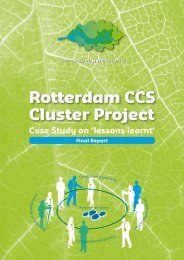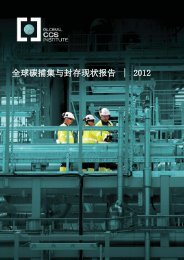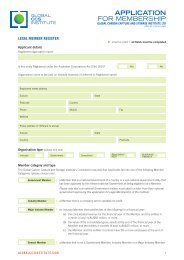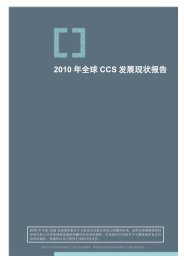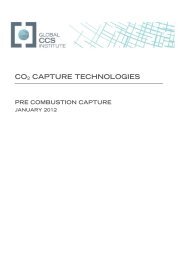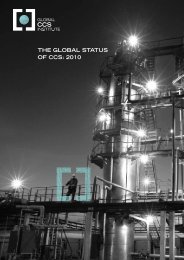Perceptions of CO2 Report - Global CCS Institute
Perceptions of CO2 Report - Global CCS Institute
Perceptions of CO2 Report - Global CCS Institute
- No tags were found...
Create successful ePaper yourself
Turn your PDF publications into a flip-book with our unique Google optimized e-Paper software.
Respondents were provided with either only one <strong>of</strong> these four information packages, orcombinations <strong>of</strong> them, creating conditions as shown in Table 1 below. Measures used in theanalysis determined whether the provision <strong>of</strong> information influenced respondents’ understandingand perceptions <strong>of</strong> CO 2 and <strong>CCS</strong>.Table 1: Combination <strong>of</strong> information presented within survey conditionsConditionCombination <strong>of</strong> information1 Part A – CO 2 properties2 Part B – CO 2 impact & natural phenomena3 Part C – CO 2 behaviour in <strong>CCS</strong>4 Parts A and B – CO 2 properties and CO 2 impact & natural phenomena5 Parts A and C – CO 2 properties and CO 2 behaviour in <strong>CCS</strong>6 Parts B and C – CO 2 impact & natural phenomena and CO 2 behaviour in <strong>CCS</strong>7 Parts A, B and C – CO 2 properties, CO 2 impact &natural phenomena, and CO 2 behaviour in <strong>CCS</strong>8 (Control 1) Part D – Information and diagram on <strong>CCS</strong>9 (Control 2 a ) Part D – Information and diagram on <strong>CCS</strong> (Question order: 10, 13, 14, 15, 11, 12)a. Control condition 2 was identical to Control condition 1; however, for Control 2, the questions measuring <strong>CCS</strong> perceptions andacceptance <strong>of</strong> implementation were presented later in the questionnaire instead <strong>of</strong> directly after the provided information. This wasdone to explore the effect <strong>of</strong> questions in this second part <strong>of</strong> the survey on respondent’s perception and acceptance after thecompletion <strong>of</strong> the questionnaire. Apart from the order <strong>of</strong> these questions, the survey was identical for all respondents.5.5 Second assessment: <strong>CO2</strong> impression, <strong>CCS</strong> impression and <strong>CCS</strong>acceptance measuresFollowing the provision <strong>of</strong> information, respondents were assessed for a second time on theirperceptions <strong>of</strong> CO 2 , perceptions <strong>of</strong> <strong>CCS</strong>, and opinions on whether they would accept <strong>CCS</strong>implementation. This was considered the second assessment.5.6 Responses collected: Additional <strong>CCS</strong> perceptions and demographicinformationSeveral questions were then asked to examine respondents’ understanding <strong>of</strong> CO 2 ’s behaviourand the consequences <strong>of</strong> <strong>CCS</strong>. First, respondents could indicate how likely they believed it to bethat certain potential consequences <strong>of</strong> <strong>CCS</strong> would occur using a 5-point scale ranging from ‘1’ (notlikely), to ‘5’ (very likely) 6 . Second, respondents were provided with statements about true anduntrue consequences <strong>of</strong> <strong>CCS</strong>. For each, they were able to indicate whether they believed it was apossible consequence or not on a similar 5-point scale, where ‘1’ meant they were certain it couldnot occur, and 5 meant they were certain it could occur 7 . Finally, respondents received another set<strong>of</strong> statements containing arguments about <strong>CCS</strong> brought forward by people in the interviews andfocus groups. For each statement, the respondents could indicate to what extent they agreed on a5-point scale.6 This was referred to as the “likelihood” section.7 This was referred to as the “misconception” section.12 | Understanding how individuals perceive carbon dioxide




